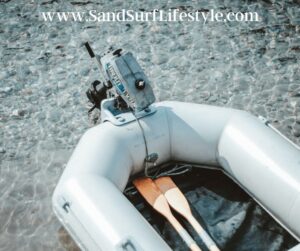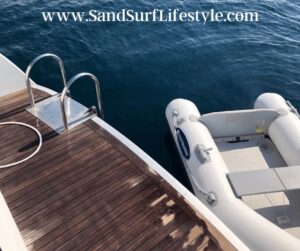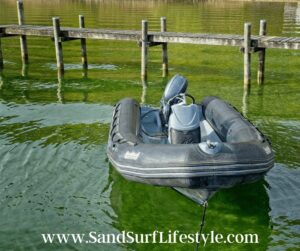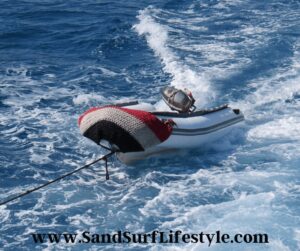We’ve all been to the beach and seen it — those people sailing by on dinghies, looking like they’re having the time of their lives. Now, after years of wondering about dinghy sailing, you’re finally getting ready to try it out for yourself! That’s fantastic! Dinghy sailing is an incredible, highly recommended, and deeply enjoyable watersport. However, before you can go sailing through the water on a dinghy, you’ll want to ensure you have everything you need so that you can have an enjoyable, efficient, and safe experience.
Before you can go dinghy sailing, you’ll need to gather the necessary equipment.
 Selecting the Correct Dinghy:
Selecting the Correct Dinghy:
People go dinghy sailing for a variety of reasons, and this means that there are different types of dinghies available. It’s imperative you select the correct one not only for your sailing goals but also for your current skill level.
Some people dinghy sail for the thrill of racing. Others do it for socialization and recreational fun. Fortunately, finding the best type of dinghy for your needs is simple since there are only a few primary categories, listed below.
1) High-Performance Dinghies:
These dinghies are extremely fast. They are so fast that they are used for Olympic and other expert-level dinghy sailing. They are also immensely powerful and effective. They can also plane extremely well, and don’t succumb easily to upwind conditions.
2) Racing Dinghies:
These dinghies are extremely popular among those who sail competitively. The performance levels on racing dinghies vary, but the most important thing to know about them is that they are very, VERY fast.
3) Cruising Dinghies:
These dinghies are created intentionally for relaxation and recreational sailing. They are also the most stable, and thus among the best options for beginners. Some of these are even made for long-distance trips or leisurely activities onboard (ex: having a picnic or a light social gathering).
Out of all the dinghies, these are also the safest for family outings.
4) Cruiser-Racer Dinghies:
The cruiser-racer dinghy is a crossover between the racing dinghy and the cruising one. These keep many of the best elements of both and combine them for a speedier and edgier, but still leisurely, dinghy sailing experience. In other words, they are great for racing and for cruising — although not necessarily at the same time. Which you use it for just depends on the intent of the outing.
5) Classic Dinghies:
The classic dinghy is not made for high performance. Rather, these are the ones you’ll want for aesthetic and changeability. They also double as useful yacht tenders and shore boats.
Picking Out the Right Attire for Your Dinghy:
Choosing the right clothes for dinghy sailing helps to ensure your safety and comfort while onboard. To go dinghy sailing, you’ll need the correct weather-appropriate bodywear, sturdy shoes, and sailing gloves.
 1) Weather-Appropriate Bodywear:
1) Weather-Appropriate Bodywear:
What you wear on your body when you go dinghy sailing depends entirely on the weather. For warmer days, a rash guard or UV technical shirt (preferably long-sleeved) is best for covering the torso. For bottom-wear, boat shorts are a popular choice among dinghy sailors, although those who do it more actively or competitively may prefer spandex ones. Both are appropriate attire for warm weather conditions.
For chillier days, diving suits are preferable. It is strongly recommended, however, that these be reserved only for cooler days at sea. Wearing these on warmer days can result in overheating and heavy discomfort, both of which can become very risky for sailors in charge of navigating a dinghy safely back to shore. Still, remember that it is generally chillier out at sea than it is on land. Always be prepared for shifting temperatures and water conditions.
Experts also recommend keeping a sailing jacket onboard. These can be useful as an extra layer of protection against the elements when needed.
2) Sturdy Shoes:
Having reliable shoes while dinghy sailing is important both for safety and for general efficiency. The best options are water shoes or boots.
Water shoes generally have soles with a strong grip, cover the entire foot (including the toes), and dry quickly. They are also very easy to put on and take off.
If you opt for a pair of these, be sure that they are snug, but not too tight. They need to be snug to prevent water from getting in through the tops, especially since this can easily flood and, therefore, weigh down your shoes. This also counteracts certain needless accidents onboard.
Conversely, shoes that are too tight will prevent enough blood from getting to your feet. This can cause issues with general mobility, flexibility, and comfort — all of which are crucial for a safe, enjoyable, and efficient sailing experience.
Boots intended for water sports also come highly recommended. The options for these are ankle-high and knee-high — which you choose just comes down to preference. Either way, be sure that whatever boots you buy have a strong bottom grip (especially in wet conditions), fit snugly, and dry quickly.
Regardless of whether you buy water shoes or boots, double-check to make sure that they are also boat-friendly — meaning that they are well-suited for moving around the dinghy safely, quickly, and with ease.
3) Sailing Gloves:
Gloves are another important item while dinghy sailing and are vital regardless of the weather conditions. These protect you from the elements and help you maintain a solid grip. The two types to choose from are fingerless gloves, which are terrific for the freedom and flexibility of the fingers, and full-fingered ones, which are better for protecting your hands from the elements and keeping your fingers slightly warmer.
It just comes down to personal choice, and sometimes even the weather. Whichever you choose, just make sure they are optimized for water sports and won’t get slippery when wet.
A secure hat with a visor, a pair of sunglasses with UV protection, and sunscreen are also advised for dinghy sailors of all skill levels.
Heading out into the waves but not sure what a deadrise in a boat is?
Learn what it is and how it affects your sailing here.
 Obtaining the Right Buoyancy Aid:
Obtaining the Right Buoyancy Aid:
While this technically could have been included in the previous section, it is vital enough that it demands its own. Acquiring a buoyancy aid, especially one that is right for you, is one of the most critical parts when preparing to go dinghy sailing. This item is life or death, and therefore, mandatory regardless of the weather, season, general outdoor conditions, type of dinghy, or your skill level as a sailor or swimmer. Even the professionals wear these and strongly urge you to do the same.
A sailing-specific life jacket is the best option for dinghy sailors. When picking one out, ensure the following: 1) that it is well-fitting — meaning that it is smooth and snug across your upper body, and not too loose, but not too tight, either; 2) that, in accordance with the previous point, it is comfortable and allows for a full range of arm motion; and 3) that it is United States Coast Guard approved.
Invest the time and effort into finding the right one. Should you ever actually meet with hazardous conditions or an unfortunate event at sea, your buoyancy aid could very well save your life.
Selecting a Pair of Oars:
Oars are another piece of equipment you’ll need for dinghy sailing. Without them, you won’t be able to steer or move your dinghy.
Make sure your oars are flat and wide at the endpoints. These are not to be confused with the paddles you might use for kayaking. With the oars you’ll need for dinghy sailing, there should be only one blade per oar, and on a single endpoint — not one on both.
Many dinghy sailors are a fan of aluminum oars, but whatever you choose, just ensure that they are durable, reliable, and easy for you to manage.
Acquiring a Set of Launching Wheels:
Launching wheels exist to make your life as a dinghy sailor much, MUCH easier. They are also sometimes referred to as dinghy wheels, but launching wheels and dinghy wheels are not necessarily the same. Most dinghy wheels are launching wheels, but some are not. Be sure to double-check this before purchasing a pair.
These wheels allow you to move your dinghy to and from your car, truck, or trailer very easily. Imagine moving to and through the beach, out to the water, and even past the initial shallow depths at the shore — or vice versa — without them! That would make for a miserable, and potentially dangerous, situation. You’ll definitely want to invest in a pair of launching wheels before attempting to hit the water with your dinghy.
Finding the Best Boat Seats:
When you’re out dinghy sailing, you’ll be on your dinghy for extended periods of time. Therefore, as we’ve already mentioned, you’ll want to be comfortable. That’s why boat seats are an important investment for your dingy.
The most common materials for boat seats are inflatable, wooden, or aluminum. Either way, when selecting the one(s) you want, just ensure that they are the correct match for your body and your needs. Any seat that doesn’t do anything beneficial for you is not one to have on your dinghy.
Whatever you end up selecting, remember that you want something that allows you to control, navigate, and row your dinghy well. The correct one(s) should increase your overall sailing efficiency.
 Purchasing a Dinghy Repair Kit:
Purchasing a Dinghy Repair Kit:
Dinghies are not infallible and, therefore, occasionally require repair and maintenance. Life is unpredictable, and this means that sometimes, you may even have to make fixes to your dinghy while already out at sea.
That’s why you’ll want to make sure that you have a dinghy repair kit onboard which includes the following items: pumps for inflation (manual or electric — as long as it works), a fastener kit, inflatable bottom paint, boat cleaner, aid fabric, keel guards, and polyvinyl chloride.
This is not a comprehensive list — merely a general one. Depending on you and your dinghy, your needs might vary outside of these items alone.
Having a Dinghy Anchor:
This is another non-negotiable item for dinghy sailing. Always have one of these on board so you can dock or set up a base anywhere you need to while sailing. These also ensure you never accidentally float away toward dangerous waters.
The type of dinghy anchor you purchase, however, does depend on the conditions in which you’re sailing. Different places have different depths, and so this will determine the length of chain you’ll need.
Please note: This blog post is for educational purposes only and does not constitute legal or medical advice. Please consult a legal expert or medical professional to address your specific needs.


 Selecting the Correct Dinghy:
Selecting the Correct Dinghy: 1) Weather-Appropriate Bodywear:
1) Weather-Appropriate Bodywear: Obtaining the Right Buoyancy Aid:
Obtaining the Right Buoyancy Aid: Purchasing a Dinghy Repair Kit:
Purchasing a Dinghy Repair Kit: